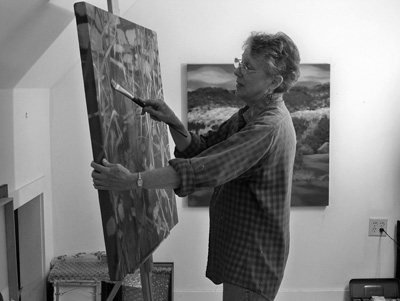News & Issues September 2015
Shutting out the noise of the world
North Bennington artist expands her creative range — and wins fans
 By TELLY HALKIAS
By TELLY HALKIAS
Contributing writer
NORTH BENNINGTON, Vt.
Judy Kniffin, seen working at her North Bennington studio, has been serious about the study and practice of art since childhood. But it wasn’t until she took early retirement and moved to Vermont in 2003 that she got to focus on oil painting and watercolor in a bigger way. Courtesy photo
For Judy Kniffin, a link to an American master in one of her parents’ past may have been the spark that led to pursuing her second life as an artist.
As a boy, Kniffin’s father, Joseph Dana Allen Jr., used to play with Andrew Wyeth whenever the latter visited relatives in Chadds Ford, Pa.
This, Kniffin said, could have been the root of a permissive creativity she was allowed to pursue when living in the Philadelphia suburbs from the late 1940s to the early 1960s.
“From the get-go, my family allowed me to draw on my bedroom walls, which I did, liberally,” Kniffin said with a laugh in her North Bennington studio.
Her family lived on a block with lots of other children, she said, and the girls often drew people and horses – with chalk on the sidewalk or on paper provided by their parents.
Her own drawings “were somewhat more anatomically correct, and thus I was designated the ‘artist’ on the block,” Kniffin recalled.
The freedom children were granted in those days to congregate unchaperoned also directly led to inspired pursuits and the development of distinct personas, she said.
“Our mothers would say, ‘And don’t come back before dinner, dearies,’” Kniffin said. “In high school, I swapped taking physics for a full-time painting class, and -- wahoo! -- I wore my hair in a sloppy French roll and didn’t shave my legs, which firmly set my high school reputation as a serious artist.”
Kniffin’s path to the Green Mountains was a lifelong odyssey in which art, and art education, played a role at every stop. After dropping out of Skidmore College in her junior year as a self-described beatnik, she continued her art training at UCLA, the Pennsylvania Academy of Fine Arts, West Chester College and numerous arts centers.
Kniffin worked as a secretary, married, and moved around the United States. She counts her decision to come to Vermont as the final step needed to energize her latent artistry.
“Marriage and motherhood made me pursue my painting around the edges of time, and usually in the kitchen or dining room, for a number of years,” Kniffin said. “Pen and ink and printmaking worked well. Watercolor was doable. But it wasn’t until I moved here and had a well-lit studio of my own that I launched into oil painting and watercolor on a larger scale.”
To make the move in 2003, Kniffin said she took early retirement from her Philadelphia-area job as a high school guidance secretary. She says it was one of the best decisions she ever made.
Straddling a fine line
Kniffin has worked in various mediums: watercolors, pastels, pen and ink, some printing methods, acrylics and oils. What ties all of these together, for her, is a fascination with figure-ground composition.
“What are the objects, and what is the background?” Kniffin said. “I really enjoy making the two resonate together, so it isn’t always obvious which is which. As I play with the figure-ground relationship, color becomes more important -- color for color’s sake.”
Tony Conner, an award-winning watercolorist from Bennington, has known and collaborated with Kniffin for years. He said she is accomplished in at least two mediums -- oil paint and watercolor.
“I’ve always found Judy’s oil paintings unique and am often struck by the unusual viewpoints, unique color choices and subtle but courageous compositions,” Conner said. “As a watercolor painter, I admire her watercolors for many reasons, not the least of which is her economical use of paint and brush stroke. She says so much with so little.”
In both mediums, Conner continued, Kniffin’s work balances on the dividing line between representation and abstraction.
“It’s easy to look at Judy’s work and quickly recognize the subject,” he said. “Yet a slight turn of the head or a change of visual focus, and you see only the abstract pattern and design.”
Jamie Franklin, an art history scholar and fine-art collector who is Bennington Museum’s curator of collections, described Kniffin’s creative efforts as a “difficult juggling act” because they “balance between realism and abstraction with subtly and grace.”
“She scrutinizes nature, in all its beauty and complexity, with the reverence of Thoreau and translates it through the eyes and hands of a sensitive modern artist,” Franklin said.
On the first encounter, he added, Kniffin’s paintings “often convey the effect of abstract, a la Jackson Pollock. But they lure the viewer into a deeper dialogue that reveals their almost photo-realist depiction of the natural world that we so often overlook.”
Franklin added that there might be no greater achievement for an artist than to encourage the viewer to look more closely and pay more attention to the visual stimulation that constantly surrounds them. These perceptions, he said, often are overlooked, lost in the busy pace of contemporary life, but can be found in Kniffin’s work.
Questioning, learning
Kniffin’s paintings have been shown regionally at public venues and private galleries, including several times a year at the Southern Vermont Arts Center in Manchester. She said the evolution of her work since her move to Vermont can be directly traced to the questions she asks about art and the surrounding world – and to the training she continues to pursue.
“I’m struggling to let go of ‘things’ and become more abstract,” Kniffin said. “Recently, someone asked me why I would want to abandon the visual world of things.”
In response, Kniffin noted that artists employ abstract design principles all the time in representational painting. They move trees, change shapes, alter the subtle color of the sky, add clouds, and take other steps that alter the world of things. This means they are often working against, or in spite of, what they are viewing and then painting, she added.
“I would like the experience, now, of reveling in pure color and composition, without arguing with what’s in my line of vision,” Kniffin said. “But what does this do for the person standing in front of the canvas, or print, or watercolor? It does present a challenge, and one that many won’t care to take on. But when they do, a viewer can get drawn into the process and enjoy it -- as a visual romp.”
Tom Fels of North Bennington is one viewer who has romped wholeheartedly into Kniffin’s creative vision. Fels, a curator and writer whose own exhibition, “Line and Shadow,” is on view through Sept. 20 at the Jackson Gallery in Middlebury, is a longtime admirer of Kniffin’s work.
“My wife and I have collected Judy’s watercolors since we first saw them 10 years ago,” Fels said. “What has always struck me about her work is not so much the mastery of technique, which is clear, but its application to achieve a successful personal style. Judy’s watercolors look like no one else’s.”
This is because Kniffin’s compositions are balanced but not tedious, Fels added. Her control of color, he said, “brings alive shadows and reflections.”
Fels said Kniffin’s sense of adventure and innovation is admirable.
“All of this is expressed through regional subjects such as buildings, landscape, streams, ponds, and the sky,” he said. “More recently, she has added abstraction. Judy is a restless artist -- ambitious, versatile, always moving on.”
Finding therapy in newness
Kniffin credits much of her own nuance to many other artists, both modern and historical, whose work she deeply admires and who have influenced her ambitious approach. Among them are Helen Frankenthaler, Willem De Kooning, Grace Hartigan and Anselm Kiefer. She also cited several Impressionists and post-Impressionists: Claude Monet, Henri Matisse, Paul Gauguin and Childe Hassam.
“What do all these painters have in common that intrigues me? I guess it’s that their work is not just visually busy, but voluptuous in line or color,” she explained.
Kniffin said several key mentors and teachers have helped her through new challenges, the most recent being Honour Mack, an artist and professor at the Maine College of Art. The two met this summer at Bennington College at the Art New England Workshop Program.
“One of the things that Judy started to understand was that she could put a painting together using color and pattern as compositional tools,” Mack said in an interview from the Maine college’s Portland campus. “Previously she relied on drawing as the primary method for organizing her images. She was very willing to try a variety of approaches -- and not the least bit timid about jumping into new processes.”
This attitude is essential for all artists, Mack said, adding that, as a result, Kniffin has been able to progress quickly and with a great deal of focus.
Ultimately, Kniffin said, for all of her art education and technical achievements, her work still echoes the nascent call of creativity from a young girl whose parents encouraged art as part of one’s inner self.
“My art -- be it painting, drawing, or print making -- has always focused me in a way nothing else can,” Kniffin said. “The process draws me in, calms me down, and directs all my senses to the task at hand. For me, it is like worship or meditation. It shuts out the noise of the world. It’s been my lifesaver through both good and rocky times.”
For more information on the art of Judy Kniffin, visit www.judykniffin.com.


